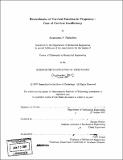Biomechanics of cervical function in pregnancy : case of cervical insufficiency
Author(s)
Paskaleva, Anastassia
DownloadFull printable version (32.07Mb)
Other Contributors
Massachusetts Institute of Technology. Dept. of Mechanical Engineering.
Advisor
Simona Socrate.
Terms of use
Metadata
Show full item recordAbstract
The uterine cervix is a passive organ in the female body. Its normal function in pregnancy is to stay firm and closed for the duration of the gestation. At term, under the action of coordinated contractions from the myometrium the cervix dilates sufficiently to allow for the delivery of the fetus. Cervical insufficiency refers to a condition in which the cervix dilates asymptomatically and painlessly in the absence of contractions from the uterine smooth muscle and results in a spontaneous pregnancy loss between the second and third trimester of pregnancy. An elusive and often misdiagnosed condition, cervical insufficiency accounts for a significant percentage of extremely premature deliveries with high incidence of infant mortality and morbidity. Accurate diagnostic criteria and treatment guidelines for this condition are not established and remain a clinical and research challenge. In an attempt to better understand the biomechanics of cervical insufficiency, a fully three-dimensional constitutive model for the large strain, time dependent mechanical behavior of the cervical stroma is proposed. The constitutive model is implemented numerically and integrated with a three dimensional solid model of the lower pelvic region of a pregnant patient into a finite element framework. The resulting finite element model provides a tool to study the effects of different clinical features on the biomechanics of the pregnant cervix and uterus, and allows to investigate the conditions that lead to a premature dilation in the case of cervical insufficiency. New findings on the mechanical behavior of the stroma emphasize the complexity of the stress-strain and volume change behavior of the stroma as well as the intricate correlation between the two. The challenges involved in prescribing a constitutive behavior for the cervical tissue include characteristics such as nonlinearity, viscoelasticity, anisotropy, inhomogeneity and preconditioning. (cont.) Additionally, the tissue behavior exhibits marked differences in tension and compression with associated stress levels differing more than an order of magnitude between the different modes of deformation. A new constitutive framework capable of capturing the complexity of tissue behavior is proposed and material properties in compression are obtained by fitting finite element model simulations to experimental data. The model is further extended to incorporate effects of anisotropy of the cervical stroma. Suitable choice of the levels of tissue anisotropy is shown to accommodate the differences between the mechanical behavior in tension and compression.
Description
Thesis (Ph. D.)--Massachusetts Institute of Technology, Dept. of Mechanical Engineering, 2007. Includes bibliographical references (p. 203-212).
Date issued
2007Department
Massachusetts Institute of Technology. Department of Mechanical EngineeringPublisher
Massachusetts Institute of Technology
Keywords
Mechanical Engineering.